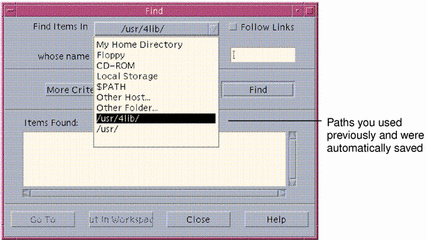To Find a File or Folder by Name
-
Open File Finder.
File Finder displays the Find dialog box.
-
Select the folder under which you expect to find the required files or folders using the following table as a guide to the menu items in the Find dialog.

Menu Item Where File Finder Searches My Home Directory Your home directory (referred to as $HOME in this chapter), for example, /home/fredj Floppy Contents of the diskette drive CD-ROM Contents of the CD-ROM drive Local Storage All folders on this workstation $PATH All folders on the workstation's default path Other Host Specify the hostname of a different workstation Other Folder Speciy another folder on this workstation Folders are arranged in a hierarchical structure ("Basic File System Concepts") By default, the Find operation will search the folder you specify and all its subfolders.
-
If you want to search across symbolic links that originate on your search path, select the Follow Links check box.
Tip -If the actual location of a linked folder is at the top level of a large number of folders, the search might take a long time. Be aware of the locations to which folders are linked before starting search operations.
-
Select whether you will be searching for a file name containing, equalling, or not containing your search text by selecting the appropriate option in the Whose Name selector.
-
Type a full or partial name of the file or folder you want to find into text box on the same line as the Whose Name selector.
Note -The following applies when you select "is equal to" from the and Name selector:
When you specify a file or folder name, you can include wildcard characters such as asterisk (*) and question mark (?). The * matches any string of characters (including no characters), and ? matches any single character. For example:
ba*-matches all names that begin with the string ba
ba?-matches all three-character names that begin with the string ba
*.dt-matches all names that end with the .dt suffix
*.???-matches all names that have a three-character suffix
The file name and contents can be specified using the same regular expression syntax allowed by the find command. (Refer to the
findman page andgrepman page for more information.)
-
Click Find.
File Manager begins searching the specified folder and its subfolders for files that match the specified search criteria. Matches that are found are listed in the Items Found list. You can stop the search at any time by clicking the Stop button.
Tip -If too many objects are returned, you can specify more restrictive criteria and try again.
-
(Optional) If you want to go to an object in the list, select it and click Go To open File Manager displaying its folder, or click Put on Workspace to display an icon for it on the workspace.
- © 2010, Oracle Corporation and/or its affiliates
